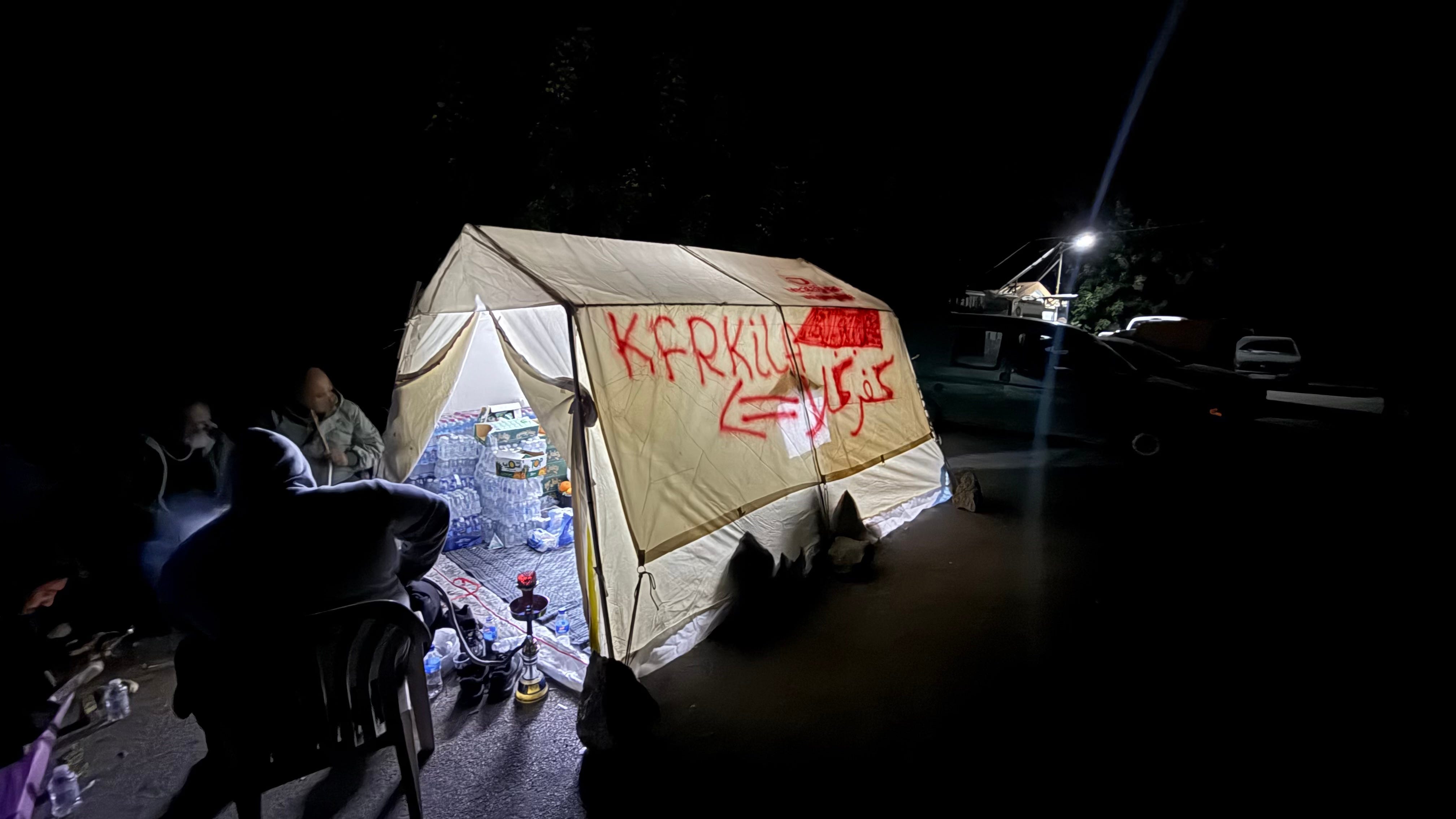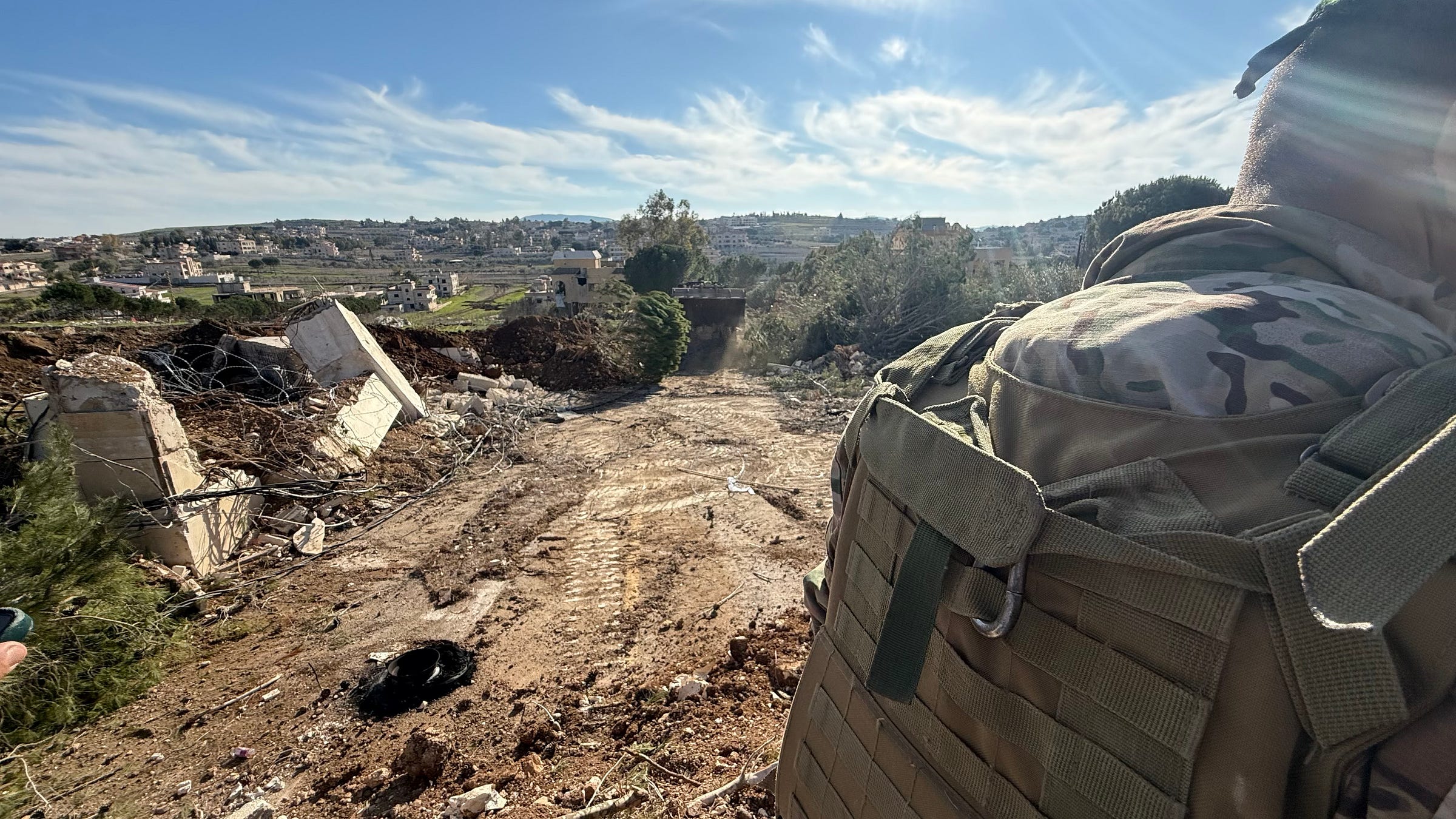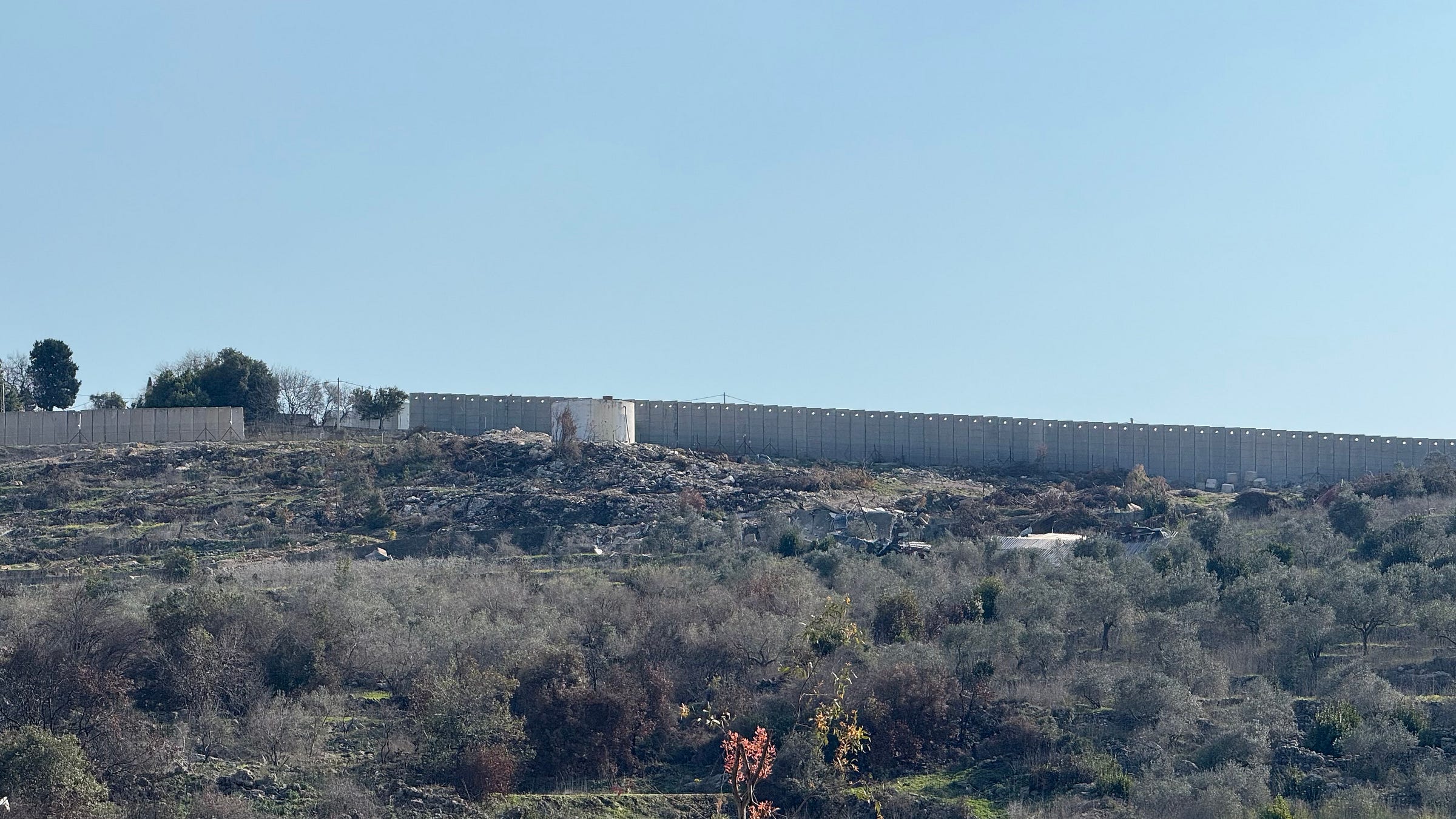In Southern Lebanon, Protests Are Growing Against the Israeli Occupation
Barred from returning home, displaced civilians from southern Lebanon are setting up camps outside their villages where Israeli troops remain

KFARKELA, LEBANON—Israeli soldiers fired on civilians trying to return home to the Lebanese village of Kfarkela last week, several eyewitnesses told Drop Site News, leaving one person dead and 15 wounded. Kfarkela is one of several towns and villages in southern Lebanon that remain occupied by the Israeli military in violation of the 60-day withdrawal deadline, which expired on January 26, as part of the U.S.-brokered ceasefire agreement between Lebanon and Israel.
The U.S. has now extended the deadline to February 18, leaving a group of displaced residents to set up tents and launch a sit-in protest against the ongoing Israeli occupation of their land.
Abu Rabea Hamoud is still unable to return home to Kfarkela 14 months after Israel heavily bombed, then invaded, the area forcing his family to flee. He is now camped out with dozens of other men several kilometers from the entrance to the village where Israeli troops have cut off access with barbed wire, barricades, and tanks.
From the encampment, protesters say they can hear Israeli tanks raiding their village and drones flying overhead. “I’ll stay here for as long as it takes—a month or longer if need be,” Hamoud told Drop Site.
Convoys of civilians that headed towards their villages on January 26 were fired on by Israeli troops. At least 27 people were killed and over 150 wounded, according to the Lebanese health ministry. Since then, displaced residents have camped outside of their villages in protest in a tense standoff with the Israeli military.
After coming under attack by Israeli forces, Hamoud’s group was forced back to their current location at the Deir Mimas-Kfarkela intersection by Lebanese army troops deployed in the area, who are also waiting for the Israeli military to withdraw to take up their positions as stipulated in the ceasefire agreement. Lebanese soldiers have since erected monitoring towers to ensure no one gets too close to the occupied village.
By day, hundreds of families gather at the sit-in to protest, bringing pots of food with them and chanting and singing nationalist songs. At night their numbers drop to a few dozen men who brave the chilly weather. Similar protest encampments have been erected outside the villages of Al-Teiba, Houla, Adeisa, Yaroun, Mais al-Jabal and elsewhere.
“Kafrkela, which the Israelis destroyed, will return to us, even if we die fighting for that,” Hamoud said, standing beside the small tent he shares with several other men. “This has got nothing to do with politics. This is a matter of lands and rights. We want to go back to our homes.”
“I won't live my life in shelters and refugee centers,” the 45-year-old father of two told Drop Site. His family remained in Beirut, where they’ve been displaced since the early days of the war. “I'm here because I want to live and rebuild my village and not be a displaced person for life.”
In a nearby tent, 18-year-old Jawad Sheet stared into the dark road leading to his village. “Since the war began, I haven’t been able to go back,” he said. “I fled with my family first to Beirut, then further north, then to Aley in Mount Lebanon. I couldn’t continue my studies or find work. What can I do away from my home?” His voice trailed off before he forced a faint smile. “If I return, the first thing I’ll do is search for our martyrs under the rubble. I’ll find their bodies and give them a proper burial.”
Israel escalated its war on Lebanon in September after a year of cross border attacks with Hezbollah, which began firing rockets and artillery at Israeli forces one day after Israel began its genocidal assault on Gaza. More than 4,000 people were killed and over 1.2 million forcibly displaced in the Israeli assault while large swathes of southern and eastern Lebanon were destroyed. Over 90,000 structures—including homes, businesses, agricultural facilities, schools, and water infrastructure—were damaged or destroyed by the bombardment across the country, according to the United Nations Development Program. Hezbollah also inflicted losses on the Israeli military, with scores of soldiers killed, hundreds wounded; and attacked Israeli towns and military installations, forcing tens of thousands of Israeli settlers to evacuate their homes in northern Israel.
Under the terms of the ceasefire deal which went into effect on November 27, Israel agreed to withdraw its troops from south Lebanon while Hezbollah pledged to end its armed presence in the area, moving its fighters and weapons north of the Litani River. Lebanese troops and UN forces would deploy to the south, an area that has been devastated by Israeli attacks over the past year.
But when the deadline expired on January 26, Israel announced its forces would remain in parts of southern Lebanon, accusing Hezbollah of not sufficiently pulling back. Lebanon denied the claim and urged Israel to honor the agreement. Over the past two months, Israel has violated the agreement hundreds of times, launching repeated attacks against what it claimed were Hezbollah targets in southern Lebanon.
“Throughout the ceasefire since November, and still today, Israeli forces continue to open fire, carry out strikes, and demolish civilian infrastructure, causing daily devastation and civilian casualties in southern Lebanon,” Francois Zamparini, the emergency coordinator for Doctors Without Borders in Lebanon, said in a statement on Monday.
Hundreds of thousands of displaced Lebanese residents have been able to return to their homes in the south only to find massive levels of destruction. However, over 100,000 have been barred from returning, with Israeli tanks and troops continuing to occupy eight villages.

Forty kilometers south of Kafrkala, in the Bint Jbeil district, dozens of residents displaced from the village of Yaroun gather every day at the village entrance waving Lebanese and Hezbollah flags and demanding Israel’s withdrawal. Behind them, UN forces — who under the agreement are to deploy, along with the Lebanese army, in areas Israel withdraws from —stand watch, while in front, Lebanese soldiers stand facing Israeli troops stationed nearby.
The village—visible in the background—has been devastated by the Israeli military. Dozens of homes have been razed and the streets are covered in rubble. Israeli bulldozers continue to tear through the earth, uprooting trees and destroying the land as the crowd chanted for the Israeli military to withdraw. At least 14 people have been wounded by Israeli sniper fire on three different occasions at Yaroun, according to Lebanon’s health ministry.
Houreya Tohfa, an elderly woman displaced from Yaroun, hasn’t been able to return to her home in ten months. “Leave, Israeli. That’s my house!” she called out, standing just several meters away from the Israeli tanks and bulldozers. “Every time I look toward Yaroun’s entrance, I see my home, but it’s not the same anymore,” she told Drop Site. “The Israelis raid it daily, destroying what little is left.”
Tohfa and her family fled north to Aramoun in March. When the deadline for Israel’s withdrawal expired last week, they tried to return home. “They wouldn’t let us in,” she says bitterly. “How can a village be stripped from its own people?”
She also directed her anger at the Lebanese army, who have refused to confront Israel. “We need real intervention. We need new resistance to push back—because Israel won’t stop unless it’s forced to,” she said.
Lebanon’s army has long navigated the country’s sectarian divisions while steering clear of direct conflicts with Israel, in stark contrast to Hezbollah’s armed wing, which has repeatedly battled Israel over the years and is one of the main fighting forces in the Axis of Resistance, the loose coalition of both nation-states and non-state actors in the Middle East who pledged to jointly oppose Israel.

Further west, the village of Duhaira, just across the border from the Israeli settlement of Arab al-Aramsha, remains a ghost town. While life continues in Arab al-Aramsha, with mosques still broadcasting the call to prayer, Duhaira lies in ruins, with homes leveled, farmland razed and craters in the earth where wells once stood.
Israeli forces withdrew from Duhaira on January 26 leaving the village in ruins. Many residents who returned to check on their homes left again after surveying the devastated landscape. Israeli snipers still fire at groups gathering near the village.
As they have on other occasions, Israeli troops crossed the border on January 30 to stage a brief incursion into Duhaira, continuing to bulldoze the little farmland that remained.
Jawad Abu Salem, a tobacco farmer in his thirties from Duheira, stood surveying the devastation. “My crops used to bring in over $10,000 a season. Now I have nothing. The land I farmed is just craters, and my home is rubble,” he said.
Forced to flee north at the start of the war, he chose to relocate to the coastal city of Sidon after returning to Duhaira, seeing his hometown destroyed and Israeli forces continuing to shoot at residents. Like many others in Lebanon, he is waiting for a real ceasefire to take hold in the distant hope that he can rebuild.
“I never wanted war. But the enemy spares no one,” he said.
This piece was published in collaboration with Egab.




What is there to say anymore? The US in an unresisted coup. Allies are now enemies. No country immune to the fascist Trump/Musk onslaught, including the.”homeland “. The international and domestic resistance has to occur. Yet no one or any country has an answer to this insanity. The previous US administration set up the path for what is ensuing. Biden has signed a deal with a company to promote his wonderful legacy. Hakeem Jeffries says “god is on the throne “. Hold your powder. Schumer says “people are aroused, aroused.” That’s the resistance at home and the whole world watches in horror as to what comes next.
People have to stop thinking that government are going to fix the on going humanitarian situations in the world. It will take individual soldiers and people involved to refuse to carry out the ongoing miss treatment of people. There has been a dehumanizing of the Israel people with generations of propaganda.
We bind ourselves through karma to all the people we harm. This will take a change in consciousness and moral courage.